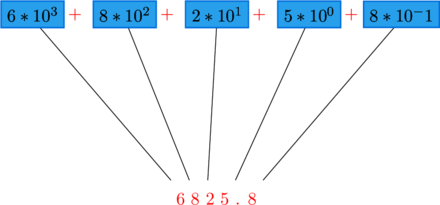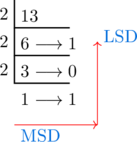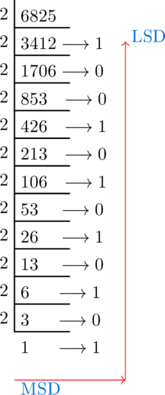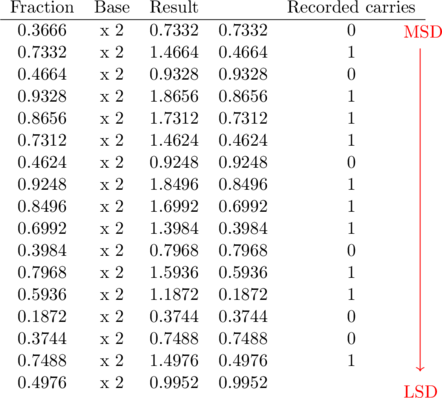Do you know? How to do decimal to binary conversion? If not? Then let me explain to you, how to do that?
We can write a decimal number suppose 6825.8 and can be represented like this
6000+800+20+5+0.8 =6825.8
Also, we can write 6825.8 as ![]() where 10 is called base
where 10 is called base

The position values for decimal number are power’s of 10

There are two methods by which you can do decimal to binary conversion
First method
Find the decimal to the binary conversion of 13
Divide the value 13 by 2 till you get 0 or 1 as a remainder

Conversion step’s
First: divide the value 13 with value 2 and the remainder will be 1
13 ![]() 2 =6 and remainder is 1
2 =6 and remainder is 1
Second: divide the 6 with 2 and the remainder will be 0
6 ![]() 2=3 and the remainder is 0
2=3 and the remainder is 0
Third: divide the 3 with 2 and the remainder will be 1
3 ![]() 2=1 and the remainder is 1
2=1 and the remainder is 1
Write down all the remainder values from downward’s to upward
A binary value of 13 is 1101
Binary to Decimal conversion
find the binary to the decimal conversion of 1101

![]()
![]()
A decimal value of 1101 is 13
Convert the decimal number 0.128906211 into a binary equivalent number

Conversion step’s
first: multiply the fraction decimal number 0.128906211 with 2 the result will be 0.257812422
write the first digit of 0.257812422 as recorded carries 0
second: multiply the fraction decimal number 0.257812422 with 2 the result will be 0.515624844
write the first digit of 0.515624844 as recorded carries 0
third: multiply the fraction decimal number 0.515624844 with 2 the result will be 1.031249688
write the first digit of 1.031249688 as recorded carries 1
fourth: multiply the fraction decimal number 0.031249688 with 2 the result will be 0.062499376
write the first digit of 0.062499376 as recorded carries 0
fifth: multiply the fraction decimal number 0.062499376 with 2 the result will be 0.124998752
write the first digit of 0.124998752 as recorded carries 0
sixth: multiply the fraction decimal number 0.124998752 with 2 the result will be 0.249997504
write the first digit of 0.249997504 as recorded carries 0
seven: multiply the fraction decimal number 0.249997504 with 2 the result will be 0.499995008
write the first digit of 0.499995008 as recorded carries 0
eight: multiply the fraction decimal number 0.499995008 with 2 the result will be 0.999990016
write the first digit of 0.499995008 as recorded carries
write down the recorded carries values from upward to downward
the binary value of 0.128906211 is 0.00100001
as you can note: the fractional values of decimal number 0.128906211 are continuous in nature because of that, I just took only 8 fractional values which made the result as an approximate result
the accurate result can be acquired by continuously multiplying by 2 until we get many digits
Convert decimal number 0.7412 to its binary equivalent
Multiply the value 0.7412 by 2 till you get the 0 and record carries in that process

As you can notice the fractional values are continuous so that I just took 20 fractional values,It is an approximate value
if we want accurate value then we need to continue to multiply by 2 till we have many digits
A binary value of 0.7412 is 0.10111101101111110101
Find the decimal to the binary conversion of 6825.3666
Step 1: separate the integer part and fractional part
Integer part: 6825 fractional part:0.3666
Step 2: find the binary equivalent for the integer part

A binary value of 6825 is 1101010101001
Step 3: Find the binary equivalent for the fractional part

The binary value of 0.3666 is approximate value as I took only 17 fractional values to get the accurate value you need to continually multiple by 2 till you get multiple values
The binary value of 0.3666 is 0.01011101110110011
Step 4: combine the binary equivalent of integer and the fractional part
A binary value of 6825.3666 is 1101010101001.01011101110110011
Second method

Find the binary equivalent of decimal 13
![]()
Step1 : Select the nearest of 13 or less than 13 value from the above table
The nearest value of 13 is 8 so, keep in place of 8 as 1

Step2: subtract the value 8 with 13
13-8 =5
Step3 : Select the nearest of 5 or less than 5 value from the above table
The nearest value of 5 is 4 so, keep in place of 4 as 1

Step4: subtract the value 5 with 4
5-4 =1
Step5 : Select the nearest of 1 or less than 1 value from the above table
The nearest value of 1 is 1 so, keep in place of 1 as 1

Step6: subtract the value 1 with 1
1-1 =0
If you get 0 value at the end then you need to finish the process and apply zero value to the remaining elements

The binary value of 13 is 1101


Leave a Reply